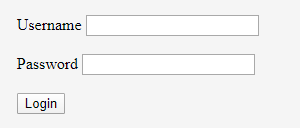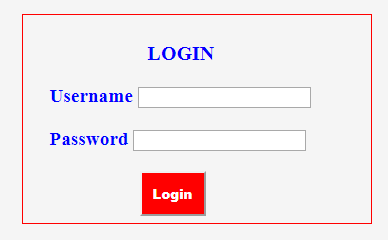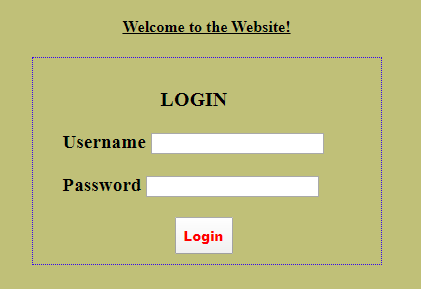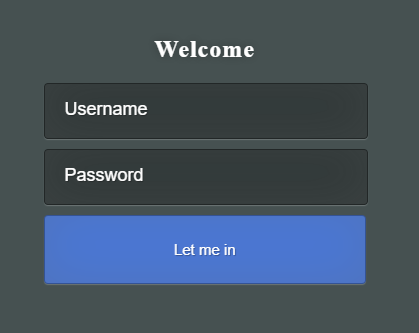PHP Login Template
In this article, we will learn about PHP Login Template. The moment we talk about a web application, we need to have a login page to get access to it. This is one of the basic requirements to have the login page. The Login Page is one of the required pages where there is restricted access in any web application. Most of the login page comes up with the two fields only. Usually, the username is considered the first field and the second one will be the password one. There is no fixed opinion for the login page template. We can go with any login page template as per our business requirements.
ADVERTISEMENT Popular Course in this category PHP DEVELOPER - Specialization | 8 Course Series | 3 Mock TestsStart Your Free Software Development Course
Web development, programming languages, Software testing & others
Syntax:
As per the syntax of the login page is concerned, there is no thumb rule to follow while working for the login page design. In this article, we will see a few examples of the login template. If we ask 5 people to come up with a login page template or the design, they could come up with 5 different as there are no industry standards as per its look and feel is concerned. So, in the coming sections, we will see the progressive view of the login page template and how we can create this page as well.
How does it work?
Any login page in the PHP is not possible by using the PHP only. A template of the PHP Login combines the various other technology like JavaScript, HTML, CSS, MySql database, etc. Now, let’s see the role of each entity one by one.
HTML: HTML is one of the basic building blocks of any web page of the application. The required of the login page will be written in this HTML only.
Code:
<!DOCTYPE html> <html> <head> <title>Page Title</title> </head> <body style="margin-left: 20%; margin: 5%;"> <form method="post" action="" name="login_form"> <div class="form-element"> <label>Username</label> <input type="text" name="username" id="username" required /> </div> <br> <div class="form-element"> <label>Password</label> <input type="password" name="password" id="password" required /> </div> <br> <button type="submit" name="Login" value="Login">Login</button> </form> </body> </html>
Output:

We can see, the look and the UI of this page is not professional enough we can move ahead with.
- CSS: CSS is again the very basic need in the web application. We can use this CSS to beautify our login page. We have various options available in the CSS we can use to put a professional look of the above login page. We can use the background color of the form. We can use the border of the form and various other related things.
- JavaScript/jQuery: A JavaScript is one of the scripts we can use for the client-side validation. We can use JavaScript to display the error message as per our business needs. For example, we can stop the form submission if any of the fields (either username or password or both) is not filled. This is again a value-added if we use JavaScript or jQuery in while coding for the login page.
All the above mentioned is good enough for designing a login page. But if we want to process with the complete login then we need to have the PHP and a Database (MYSQL or any other) as well.
Examples to Implement PHP Login Template
Now, it’s time to see various login page examples. We are moving ahead with the same HTML code mentioned above. We will see various templates using the above code or making a bit of modification in the above code.
Example #1
Code:
<!DOCTYPE html>
<html>
<head>
<title>Page Title</title>
</head>
<body>
<form method="post" action="" name="login_form" id="login_form">
<div class="form-element">
<label class="head">Login </label>
</div>
<div class="form-element">
<label>Username</label>
<input type="text" name="username" id="username" required />
</div>
<div class="form-element">
<label>Password</label>
<input type="password" name="password" id="password" required />
</div>
<button type="submit" id="Login" name="Login" value="Login">Login</button>
</form>
</body>
<style>
body{margin-left: 30%; margin-top: 5%; max-width: 350px;}
.head {
margin-left: 98px;
font-size: 20px;
font-weight: 900;
text-transform: uppercase;
}
#login_form{
color: blue;
font-size: larger;
border: 1px solid red;
padding: 7px;
}
.form-element{margin: 20px;}
#Login{
font-weight: 900;
background: red;
margin-left: 110px;
padding: 11px;
color: #fff;
}
label{font-weight: 900;}
</style>
</html>Output:

Example #2
In this login page template, we will see the more interactive as compared to the previous one. We will be using some more advanced CSS.
Code:
<!DOCTYPE html>
<html>
<head>
<title>Login Page</title>
</head>
<body>
<h4>Welcome to the Website!</h4>
<form method="post" action="" name="login_form" id="login_form">
<div class="form-element">
<label class="head">Login </label>
</div>
<div class="form-element">
<label>Username</label>
<input type="text" name="username" id="username" required />
</div>
<div class="form-element">
<label>Password</label>
<input type="password" name="password" id="password" required />
</div>
<button type="submit" id="Login" name="Login" value="Login">Login</button>
</form>
</body>
<style>
body{
margin-left: 30%;
margin-top: 5%;
max-width: 350px;
background: #c0c078;
}
.head {
margin-left: 98px;
font-size: 20px;
font-weight: 900;
text-transform: uppercase;
}
#login_form{
font-size: larger;
border: 1px dotted #3406ed;
padding: 10px;
}
.form-element{margin: 20px;}
#Login{
font-weight: 900;
margin-left: 132px;
padding: 7px;
color: red;
}
label{font-weight: 900;}
h4{text-align: center; text-decoration: underline;}
</style>
</html>Output:

Example #3
In this example, we will see the different than the above two Login page layout.
Code:
<!DOCTYPE html>
<html>
<head>
<title>Login Page</title>
</head>
<body>
<form method="post" action="" name="login_form" id="login_form">
<div class="form-element">
<h2>Welcome </h2>
<input type="text" name="username" id="username" placeholder="Username" required />
<input type="password" name="password" id="password" placeholder="Password" required />
<input type="submit" id="submit" value="Let me in" />
</div>
</form>
</body>
<style>
html{
width: 100%;
height: 100%;
overflow: hidden;
}
body {
width: 100%;
height:100%;
background: #465151;
}
h2{
color: #fff;
text-shadow: 0 0 10px rgba(0,0,0,0.3);
letter-spacing: 1px;
text-align: center;
}
input {
width: 100%;
line-height: 4;
margin-bottom: 10px;
background: rgba(0,0,0,0.3);
border: none;
outline: none;
font-size: 13px;
color: #fff;
text-shadow: 1px 1px 1px rgba(0,0,0,0.3);
border: 1px solid rgba(0,0,0,0.3);
border-radius: 4px;
box-shadow: inset 0 -5px 45px rgba(100,100,100,0.2), 0 1px 1px rgba(255,255,255,0.2);
-webkit-transition: box-shadow .5s ease;
-moz-transition: box-shadow .5s ease;
-o-transition: box-shadow .5s ease;
-ms-transition: box-shadow .5s ease;
transition: box-shadow .5s ease;
}
#submit{
background-color: #4a77d4;
padding: 25px 14px;
font-size: 15px;
line-height: normal
}
form#login_form {
width: 30%;
margin-left: 30%;
margin-top:100px;
}
::placeholder {
color:#fff;
font-size: 18px;
padding-left: 20px;
}
</style>
</html>Output:

Conclusion
PHP Login page is one of the required things in this era of the digital revolution. Since there is not any standard of making the login page template, so we can move ahead of any template as per our business requirements. It is always advisable to use the client-side validation before posting any login page request to the server.
The above is the detailed content of PHP Login Template. For more information, please follow other related articles on the PHP Chinese website!

Hot AI Tools

Undresser.AI Undress
AI-powered app for creating realistic nude photos

AI Clothes Remover
Online AI tool for removing clothes from photos.

Undress AI Tool
Undress images for free

Clothoff.io
AI clothes remover

Video Face Swap
Swap faces in any video effortlessly with our completely free AI face swap tool!

Hot Article

Hot Tools

Notepad++7.3.1
Easy-to-use and free code editor

SublimeText3 Chinese version
Chinese version, very easy to use

Zend Studio 13.0.1
Powerful PHP integrated development environment

Dreamweaver CS6
Visual web development tools

SublimeText3 Mac version
God-level code editing software (SublimeText3)

Hot Topics
 1673
1673
 14
14
 1428
1428
 52
52
 1333
1333
 25
25
 1278
1278
 29
29
 1257
1257
 24
24
 PHP vs. Python: Understanding the Differences
Apr 11, 2025 am 12:15 AM
PHP vs. Python: Understanding the Differences
Apr 11, 2025 am 12:15 AM
PHP and Python each have their own advantages, and the choice should be based on project requirements. 1.PHP is suitable for web development, with simple syntax and high execution efficiency. 2. Python is suitable for data science and machine learning, with concise syntax and rich libraries.
 PHP: A Key Language for Web Development
Apr 13, 2025 am 12:08 AM
PHP: A Key Language for Web Development
Apr 13, 2025 am 12:08 AM
PHP is a scripting language widely used on the server side, especially suitable for web development. 1.PHP can embed HTML, process HTTP requests and responses, and supports a variety of databases. 2.PHP is used to generate dynamic web content, process form data, access databases, etc., with strong community support and open source resources. 3. PHP is an interpreted language, and the execution process includes lexical analysis, grammatical analysis, compilation and execution. 4.PHP can be combined with MySQL for advanced applications such as user registration systems. 5. When debugging PHP, you can use functions such as error_reporting() and var_dump(). 6. Optimize PHP code to use caching mechanisms, optimize database queries and use built-in functions. 7
 PHP and Python: Comparing Two Popular Programming Languages
Apr 14, 2025 am 12:13 AM
PHP and Python: Comparing Two Popular Programming Languages
Apr 14, 2025 am 12:13 AM
PHP and Python each have their own advantages, and choose according to project requirements. 1.PHP is suitable for web development, especially for rapid development and maintenance of websites. 2. Python is suitable for data science, machine learning and artificial intelligence, with concise syntax and suitable for beginners.
 PHP in Action: Real-World Examples and Applications
Apr 14, 2025 am 12:19 AM
PHP in Action: Real-World Examples and Applications
Apr 14, 2025 am 12:19 AM
PHP is widely used in e-commerce, content management systems and API development. 1) E-commerce: used for shopping cart function and payment processing. 2) Content management system: used for dynamic content generation and user management. 3) API development: used for RESTful API development and API security. Through performance optimization and best practices, the efficiency and maintainability of PHP applications are improved.
 The Enduring Relevance of PHP: Is It Still Alive?
Apr 14, 2025 am 12:12 AM
The Enduring Relevance of PHP: Is It Still Alive?
Apr 14, 2025 am 12:12 AM
PHP is still dynamic and still occupies an important position in the field of modern programming. 1) PHP's simplicity and powerful community support make it widely used in web development; 2) Its flexibility and stability make it outstanding in handling web forms, database operations and file processing; 3) PHP is constantly evolving and optimizing, suitable for beginners and experienced developers.
 PHP and Python: Different Paradigms Explained
Apr 18, 2025 am 12:26 AM
PHP and Python: Different Paradigms Explained
Apr 18, 2025 am 12:26 AM
PHP is mainly procedural programming, but also supports object-oriented programming (OOP); Python supports a variety of paradigms, including OOP, functional and procedural programming. PHP is suitable for web development, and Python is suitable for a variety of applications such as data analysis and machine learning.
 PHP vs. Other Languages: A Comparison
Apr 13, 2025 am 12:19 AM
PHP vs. Other Languages: A Comparison
Apr 13, 2025 am 12:19 AM
PHP is suitable for web development, especially in rapid development and processing dynamic content, but is not good at data science and enterprise-level applications. Compared with Python, PHP has more advantages in web development, but is not as good as Python in the field of data science; compared with Java, PHP performs worse in enterprise-level applications, but is more flexible in web development; compared with JavaScript, PHP is more concise in back-end development, but is not as good as JavaScript in front-end development.
 PHP and Python: Code Examples and Comparison
Apr 15, 2025 am 12:07 AM
PHP and Python: Code Examples and Comparison
Apr 15, 2025 am 12:07 AM
PHP and Python have their own advantages and disadvantages, and the choice depends on project needs and personal preferences. 1.PHP is suitable for rapid development and maintenance of large-scale web applications. 2. Python dominates the field of data science and machine learning.




